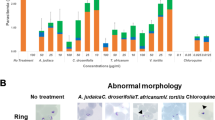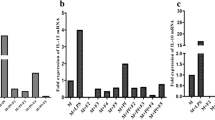Abstract
In a search for new plant-derived antimalarial extracts, 19 fractions were obtained from three Annonaceae species, Uvariopsis congolana (leaf, stem), Polyalthia oliveri (stem bark), and Enantia chlorantha (stem, stem bark) with yields ranging from 0.33% to 4.60%. The extracts were prepared from 500 g of each plant part, using organic solvents to afford five methanolic fractions (acetogenin rich), five water fractions, five hexane fractions, and four interface precipitates. Evaluation of the activity of fractions in vitro against field isolates of the malaria parasite Plasmodium falciparum showed that acetogenin-rich fractions and interface precipitates were the most potent, with IC50 values ranging from 0.05 to 8.09 μg/ml. Sensitivity of parasite isolates to plant extracts varied greatly, with over 100-fold difference from isolate to isolate in some cases. The active acetogenin-rich fractions and interface precipitates were assessed in combination with chloroquine in the same conditions, and showed additive interaction in the huge majority of cases. Synergistic interactions were found in some cases with acetogenin-rich fractions. Acute toxicity of promising fractions was evaluated through oral administration in Swiss albino mice. Tested fractions appeared to be safe, with LD50 values higher than 2 g/kg. In summary, acetogenin-rich fractions from Annonaceae species showed high potency against P. falciparum field isolates and safety by oral administration in mice, supporting their detailed investigation for antimalarial drug discovery.
Similar content being viewed by others
References
Adjanohoun JE, Aboubakar N, Dramane K, Ebot ME, Ekpere JA, Enoworock EG, Focho D, Gbile ZO, Kamanyi A, Kamsu KJ, Keita A, Mbenkum T, Mbi CN, Mbiele AC, Mbome JC, Muberu NK, Nancy WL, Kongmeneck B, Satabie B, Sofowora A, Tamze V, Wirmum CK (1996) Traditional medicine and pharmacopoeia: contribution to ethnobotanical and floristic studies in Cameroon. Ed. Organization of African Unity: Scientific, Technical and Research Commission, Addis Ababa 641p
Agbaje EO, Onabanjo AO (1991) The effects of extracts of Enantia chlorantha in malaria. Ann Trop Med Parasitol 85(6):585–590
Agbaje EO, Onabanjo AO (1994) Toxicological study of the extracts of anti-malarial medicinal plant Enantia chlorantha. Cent Afr J Med 40(3):71–73
Agomo PU, Idigo JC, Afolabi BM (1992) Antimalarial medicinal plants and their impact on cell populations in various organs of mice. Afr J Med & Med Sci 21(2):39–46
Alali FQ, Liu XX, Mc Laughlin JL (1999) Annonaceous acetogenins: recent progress. J Nat Prod 62:504–540
Bagavan A, Rahuman AA, Kaushik NK, Sahal D (2010) In vitro antimalarial activity of medicinal plant extracts against Plasmodium falciparum. Parasitol Res. doi:10.1007/s00436-010-2034-4
Boyom FF, Madiesse Kemgne EA, Tepongning R, Ngouana V, Mbacham WF, Tsamo E, Amvam Zollo PH, Gut J, Rosenthal PJ (2009) Antiplasmodial activity of extracts from seven medicinal plants used in malaria treatment in Cameroon. J Ethnopharmacol 123:483–488
Boyom FF, Ngouana V, Madiesse Kemgne EA, Amvam Zollo PH, Menut C, Bessiere JM, Gut J, Rosenthal PJ (2011a) Antiplasmodial volatile extracts from Cleistopholis patens Engler & Diels and Uvariastrum pierreanum Engl. (Engl. & Diels) (Annonaceae) growing in Cameroon. Parasitol Res 108:1211–1217
Boyom FF, Tsouh Fokou PV, Tchokouaha Yamthe LR, Ngoutane Mfopa A, Madiesse Kemgne EA, Mbacham WF, Tsamo E, Amvam Zollo PH, Gut J, Rosenthal PJ (2011b) Potent antiplasmodial extracts from Cameroonian Annonaceae. J Ethnopharmacol 134:717–724
Dondorp AM, Nosten F, Yi P, Das D, Phyo AP, Tarning J, Lwin KM et al (2009) Artemisinin resistance in Plasmodium falciparum malaria. New Engl J Med 361(5):455–467
Fernando SD, Rodrigo C, Rajapakse S (2010) The ‘hidden’ burden of malaria: cognitive impairment following infection. Malaria J 9(366):1–11
Fidock DA, Rosenthal PJ, Croft SL, Brun R, Nwaka S (2004) Antimalarial drug discovery: efficacy models for compound screening. Nat Rev Drug Discov 3:509–520
Ghosh MN (1984) In statistical analysis, fundamentals of experimental pharmacology, 2nd edn. Calcutta, Scientific Book Agency, pp 153–189
Guadaño A, Gutiérrez C, DelaPeña E, Cortes D, González CA (2000) Insecticidal and mutagenic evaluation of two annonaceous acetogenins. J Nat Prod 63:773–776
Ichino C, Soonthornchareonnon N, Chuakul W, Kiyohara H, Ishiyama A, Sekiguchi H, Namatame M, Otoguro K, Omura S, Yamada H (2006) Screening of Thai medicinal plant extracts and their active constituents for in vitro antimalarial activity. Phytother Res 20(4):307–309
John CC, Bangirana P, Byarugaba J, Opoka RO, Idro R, Jurek AM, Wu B, Boivin MJ (2008) Cerebral malaria in children is associated with long-term cognitive impairment. Pediatrics 122:e92–e99
Joshi SC, Priya SE, Venkataraman (2007) Acute and sub acute toxicities on the polyherbalantidiabetic formulation Diakyur in experimental animal models. J Health Sci 53(2):245–249
Kanokmedhakul S, Kanokmedhakul K, Kantikeaw I, Phonkerd N (2006) 2-substituted furans from the roots of Polyalthia evecta. J Nat Prod 69(1):68–72
Kanokmedhakul S, Kanokmedhakul K, Lekphrom R (2007) Bioactive constituents of the roots of Polyalthia cerasoides. J Nat Prod 70(9):1536–1538
Kimbi HK, Fagbenro-Beyioku AF (1996) Efficacy of Cymbopogon giganteus and Enantia chlorantha against chloroquine resistant Plasmodium yoelii nigeriensis. East Afr Med J 73(10):636–637
Krief S, Huffman MA, Sévenet T, Hladik CM, Grellier P, Loiseau PM, Wrangham RW (2006) Bioactive properties of plant species ingested by chimpanzees (Pan troglodytes schweinfurthii) in the Kibale National Park, Uganda. Am J Primatol 68(1):51–71
Lewis MA, Arnason JT, Philogene BJR, Rupprecht JK, McLaughlin JL (1993) Inhibition of respiration at site I by asimicin, an insecticidal acetogenin of the Pawpaw Asimina triloba (Annonaceae). Pest Biochem Physiol 45:15–23
Meletiadis J, Pournaras S, Roilides E, Walsh TJ (2009) Defining fractional inhibitory concentration index cutoffs foradditive interactions based on self-drug additive combinations, Monte Carlo simulation analysis and in vitro-in vivo correlation data for antifungal drug combinations against Aspergillus fumigatus. Antimicrob Agents Chemother. doi:10.1128/AAC.00999-09
Miller LC, Tainter ML (1944) Estimation of ED50 and its error by means of log-probit graph paper. Proceeding of the Soc Exp Biol Med 57:261
Morré DJ, DeCabo R, Farley C, Oberlies NH, McLaughlin JL (1995) Mode of action of bullatacin, a potent antitumor acetogenin: inhibition of NADH oxidase activity HeLa and HL-60 but not liver, plasma membranes. Life Sci 56:343–348
OECD (2008) Guidelines for the testing of chemicals/section 4: health effects—test no. 425: acute oral toxicity: up-and-down procedure. OECD Publishing, Paris
Rakotomanga M, Razakantoanina V, Raynaud S, Loiseau PM, Hocquemiller R, Jaureguiberry G (2004) Antiplasmodial activity of acetogenins and inhibitory effect on Plasmodium falciparum adenylatetranslocase. J Chemother 16:350–356
Rupprecht JK, Chang JM, McLaughin JL (1990) Annonaceous acetogenins: a review. J Nat Prod 53:237–278
Sanon S, Azas N, Gasquet M, Ollivier E, Mahiou V, Barro N, Cuzin-Ouattara N, Traore AS, Esposito F, Balansard G, Timon-David P (2003) Antiplasmodial activity of alkaloid extracts from Pavetta crassipes (K. Schum) and Acanthospermum hispidum (DC), two plants used in traditional medicine in Burkina Faso. Parasitol Res 90:314–317
Singh A, Rosenthal PJ (2001) Comparison of efficacies of cysteine protease inhibitors against five strains of Plasmodium falciparum. Antimicrob Agents Chemother 45:949–951
Vennerstrom JL, Klayman DL (1998) Protoberberine alkaloids as antimalarials. J Med Chem 31(6): 1084–1087
Wallace CD, Wallace HA (2001) In principles and method of toxicology, 4th edn. Taylor and Francis, Philadelphia, pp 871–873
WHO (2010) World Malaria Report. WHO Library Cataloguing-in-Publication Data 1–137
Acknowledgments
This investigation was supported by a MIM/TDR grant (A80689) to FFB, and Fobang Foundation. The authors gratefully acknowledge the expertise of the laboratory of PJR. We also acknowledge the practical help of Mr. Victor Nana of the Cameroon National Herbarium, and Dr. Nole Tsabang of the Institute of Medical Research and Medicinal Plants Studies for their assistance with the ethnobotanical survey, collection, and identification of plant materials.
Author information
Authors and Affiliations
Corresponding authors
Rights and permissions
About this article
Cite this article
Kemgne, E.A.M., Mbacham, W.F., Boyom, F.F. et al. In vitro sensitivity of Plasmodium falciparum field isolates to extracts from Cameroonian Annonaceae plants. Parasitol Res 110, 109–117 (2012). https://doi.org/10.1007/s00436-011-2456-7
Received:
Accepted:
Published:
Issue Date:
DOI: https://doi.org/10.1007/s00436-011-2456-7




